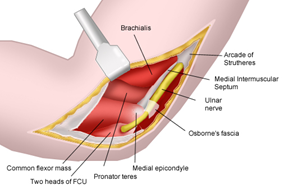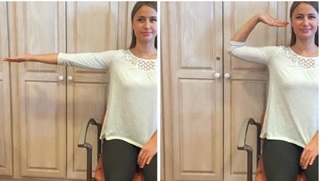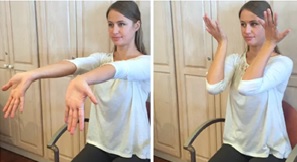
What is Cubital Tunnel Syndrome?
Cubital Tunnel Syndrome is the alternate of most common compression neuropathy in the upper extremity after carpal tunnel syndrome. Cubital tunnel syndrome is a peripheral nerve compression syndrome, It's an irritating or injury of the ulnar nerve in the Cubital tunnel at the elbow. We is also known as Ulnar nerve entrapment.

Causes
- Traction, ischemia or pressure of ulnar nerve which passes through the Cubital tunnel at medial side of the elbow.
- Someone more likely to develop Cubital tunnel syndrome if he/ she –
- Repeatedly lean on elbow, especially on a hard surface.
- Sometimes the result will be abnormal of bone growth in the elbow or from intense physical activity that increases pressure on the ulnar nerve.
- Cubital tunnel syndrome is risk of baseball pitcher twisting motion needed to throw a slider which can damage delicate ligaments
Sign and Symptoms
- Medial elbow pain or aching in forearm
- Hand pain
- Numbness and tingling sensation present in 4 th and 5 th digits, Hypothenar eminence and ulnar side of dorsum of the hand.
- Non-painful popping or snapping during passive and active flexion and extension of the elbow also reported by patient.
- Abduction of the 5 th digit due to weakness of the 3 rd palmar Interosseous muscle may be present. i.e. Wartenberg sign.
Some severe symptoms include-
- Weakness affecting the ring and little fingers ( atrophy of intrinsic muscles of hand)
- Decreased pinching ability of the thumb and little finger
- Decreased overall hand grip
- Muscle wasting in the hand
- Claw-like deformity of the hand
Diagnostic Procedure
- High-resolution neuro-ultrasonography.
- Magnetic resonance neurography (MRN)
- X-Rays
- Electrophysiological Studies
Physical Examination test
- Elbow Flexion Test
- Tinel Sign
Physiotherapy Management
Goals of treatment
- To control and decrease paranesthesia and pain.
- To increase strength of muscle
- To improve range of motion
- Activity Modification.
Rest and splinting – To control pain and Paresthesia
Icing – To reduce swelling and can be combined with gently applied range of motion exercise.
Joint mobilization – To increasing range of the motion.
Strengthening exercises – To strengthen 4 th and 5 th digits.
Activity Modification- To eliminate pain provoking activities.
Nerve gliding exercises- To stretch the ulnar nerve and encourage movement through the cubital tunnel.
- Elbow Flexion and Wrist Extension
- Head Tilt
- Arm Flexion in front of the Body
- A-OK




